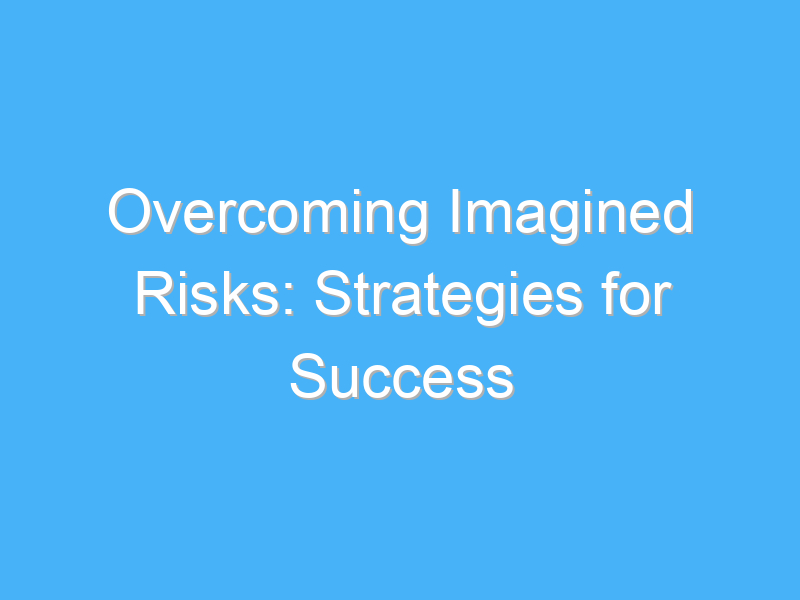
Overcoming Imagined Risks: Strategies for Success
Overcoming imagined risks can be a challenging task for individuals. It is not uncommon for people to perceive danger in situations that are not actually risky, which can lead to anxiety and other negative emotions. This topic explores the best ways to overcome imagined risks and provides strategies that individuals can use to manage their perceptions of danger effectively. By adopting these techniques, individuals can reduce their anxiety and enjoy a more fulfilling life.
The Power of Perception
The way we perceive the world around us shapes our beliefs, attitudes, and behaviors. Our perception is influenced by our experiences, values, and biases. When we perceive a situation as risky or dangerous, we tend to respond with fear and anxiety. These emotions can paralyze us and prevent us from taking action. Therefore, one of the best ways to overcome imagined risks is to change our perception of the situation.
Challenge Your Assumptions
Our assumptions can limit our perspective and prevent us from seeing things clearly. Therefore, it’s essential to challenge our assumptions and question our beliefs. For example, if you’re afraid of public speaking, you might assume that people will judge you harshly if you make a mistake. However, this assumption might not be accurate. People are generally more forgiving and understanding than we give them credit for. Therefore, challenge your assumptions and ask yourself if they are based on facts or fears.
Reframe the Situation
Another way to change your perception is to reframe the situation. Instead of seeing it as a threat, see it as an opportunity. For example, if you’re afraid of failure, you might see it as a chance to learn and grow. Reframing the situation can help you see it in a different light and reduce your anxiety.
The Role of Mindset
Our mindset is another factor that can influence our ability to overcome imagined risks. If we have a fixed mindset, we tend to see our abilities as fixed and immutable. Therefore, we’re more likely to avoid challenges and take risks. In contrast, if we have a growth mindset, we believe that our abilities can be developed through hard work and dedication. Therefore, we’re more likely to embrace challenges and take risks.
Cultivate a Growth Mindset
To cultivate a growth mindset, focus on your effort and progress rather than your innate abilities. Celebrate your successes and learn from your failures. Embrace challenges and view them as opportunities to learn and grow. By adopting a growth mindset, you’ll be more resilient and better equipped to overcome imagined risks.
The Power of Planning
Planning is another essential factor in overcoming imagined risks. When we have a plan, we feel more in control and less anxious. Therefore, creating a plan can help us overcome our fears and take action.
Break It Down
When creating a plan, start by breaking down the task into smaller, more manageable steps. This approach can help you avoid feeling overwhelmed and reduce your anxiety. For example, if you’re afraid of starting a new business, break down the task into smaller steps, such as researching the market, creating a business plan, and finding funding.
Set Realistic Goals
Setting realistic goals is another essential aspect of planning. When we set unrealistic goals, we’re more likely to fail and feel discouraged. Therefore, set goals that are challenging but achievable. Celebrate your progress along the way and adjust your goals as needed.
The Importance of Action
Finally, taking action is the most critical factor in overcoming imagined risks. Without action, all the planning, mindset shifts, and perception changes are useless. Therefore, it’s essential to take action, even if it’s small and incremental.
Start Small
If you’re feeling overwhelmed, start with small, manageable steps. For example, if you’re afraid of public speaking, start by speaking in front of a small group of friends or family members. As you become more comfortable, gradually increase the size of your audience.
Embrace Failure
Failure is an inevitable part of taking risks. Therefore, it’s essential to embrace failure and learn from it. Instead of seeing failure as a setback, see it as a valuable learning opportunity. Use your failures to improve your skills and knowledge and try again.
FAQs
What are imagined risks?
Imagined risks are fears or concerns that are not grounded in reality. They are often fueled by anxiety, uncertainty, and a lack of information. These risks can be related to anything from everyday situations to major life decisions.
How can imagined risks affect us?
Imagined risks can prevent us from taking necessary risks and trying new things. They can cause us to miss out on opportunities, limit our personal and professional growth, and negatively impact our mental well-being. Constantly worrying about imagined risks can lead to anxiety, stress, and other health issues.
What is the best way to overcome imagined risks?
The best way to overcome imagined risks is to confront them head-on. This means identifying what the specific fears or concerns are, gathering information and facts about the situation, and analyzing the potential risks and benefits. It is also important to challenge any negative self-talk or limiting beliefs that may be fueling the imagined risks.
How can we differentiate between imagined and real risks?
Imagined risks are often based on irrational thoughts and emotions rather than actual evidence. Real risks, on the other hand, are based on objective facts and evidence that can be verified. It is important to take a step back and objectively assess the situation to determine whether the risk is a true threat or simply an imagined one.
Can seeking support from others help in overcoming imagined risks?
Yes, seeking support from others can be a helpful way to overcome imagined risks. This can include talking to a trusted friend or family member, seeking guidance from a therapist or counselor, or joining a support group. Having a support system can provide reassurance, feedback, and perspective, and help to alleviate anxiety and worry.
